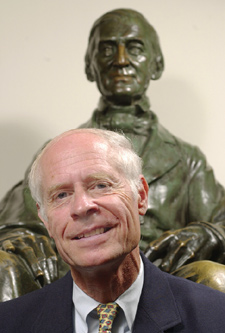Author calls for renewal of honor for heroes
Admiring venerable virtues of strength, courage, and talent
Seventy-six years ago today (Aug. 22, 1926), Charles William Eliot, Harvard’s longest-serving president, died at his summer home in Maine at the age of 92.
As the news of his death spread, obituary writers across the country geared up to recount Eliot’s achievements as a scientist, educator, writer, and a force for decades in the country’s intellectual, cultural, and moral life.

But the attention paid to Eliot was short-lived, for the very next day, silent screen superstar Rudolph Valentino died in a New York hospital of an infected stomach ulcer, touching off a national paroxysm of mourning with rioting outside the funeral home where his body lay in state. The radio and newspaper coverage was nonstop.
There were some commentators who questioned the priorities of Valentino’s grief-stricken fans. An article in the Chicago Tribune complained: “The idealist gazes, groans, and despairs of the republic. The cynic smiles at another proof that mankind cherishes those who entertain rather than those who instruct; those who help us dream rather than those who waken us to truth.” But for most Americans, the death of the man who created the “Five-Foot Shelf” of great books was shunted aside by the passing of “The Sheik.”
Peter Gibbon sees the moment when Valentino’s death upstaged Eliot’s as a significant one. For him it marks the end of America’s reverence for traditional leaders and the beginning of its love affair with celebrities, the point at which the belief took hold “that to be young and beautiful is better than to be old and wise.”
Gibbon, a research associate at the Graduate School of Education, has written a book that looks at that transition and where it has brought us. The book, “A Call to Heroism: Renewing America’s Vision of Greatness” (Atlantic Monthly Press, 2002), is also an attempt to rehabilitate the discredited notion of the hero, to remind us what such a notion might do for us as a society.
A graduate of Harvard College (Class of ’64) and former headmaster of the Hackley School in Tarrytown, N.Y., Gibbon became something of an evangelist for heroes and heroism after his high school commencement speech on three women of courage (missionary Eva Jane Price, artist Käthe Kollwitz, and writer Eugenia Ginzburg) was picked up by Newsweek magazine. The response to the piece inspired him to travel around the country, talking about heroes to high school students and following up with question-and-answer sessions.
“I try to convince audiences that we need models,” Gibbon said. “We’re imitative creatures. We need to look up and admire.”
Gibbon deplores the recent trend in biographies of the great to ferret out the most unflattering aspects of their subjects while minimizing their achievements, cutting towering figures down to size so that they seem no more than “ordinary people benefiting from a few good breaks.”
But while he advises young people to learn to appreciate heroes, he cautions against the kind of hero worship that, in its most extreme form, can lead to totalitarian dictatorship.
“If I had to choose between cynical debunking in America and fascist Germany, the choice is obvious. I’m not in favor of indoctrination, but I am in favor of idealism.”
Much of Gibbon’s book is organized around public monuments, from that most conspicuous of patriotic sculptures, the four enormous presidential heads on Mount Rushmore, to more obscure works like sculptor Horatio Greenough’s portrayal of George Washington as a naked Greek god. In each case, Gibbon tries to take a fresh look at the monument, the significance of the figure it portrays, and the ideas and feelings that led to its creation.
Musing on these monuments leads Gibbon to many insights into our changing attitudes toward heroes. In Cambridge Common, for example, he contrasts the 19th century monuments to Abraham Lincoln and Puritan elder John Bridge with the more recently erected sculptural group honoring the victims of the Irish potato famine.
“There is a movement in America today,” he writes, “to honor the victims of history.”
Not that honoring victims is necessarily a bad idea, but Gibbon believes there is also value in honoring men and women who have exhibited great talent, courage, and achievement. For one thing, giving heroes their due provides models for others to aspire to.
“Heroes make other heroes. It’s a chain reaction. Take Martin Luther King – his hero was Gandhi. Gandhi’s hero was Tolstoy, and Tolstoy was influenced by Thoreau.”
Gibbon finds fault with today’s tendency to accord hero status only to ordinary people and to depreciate those who stand above the crowd.
“There’s a feeling that it’s almost elitist to praise greatness. I take issue with the idea that everybody is equal. Some people are braver and better than others. But that doesn’t mean that we all can’t be braver and better. I think we should all celebrate greatness and genius and at the same time celebrate ordinary men and women.”




